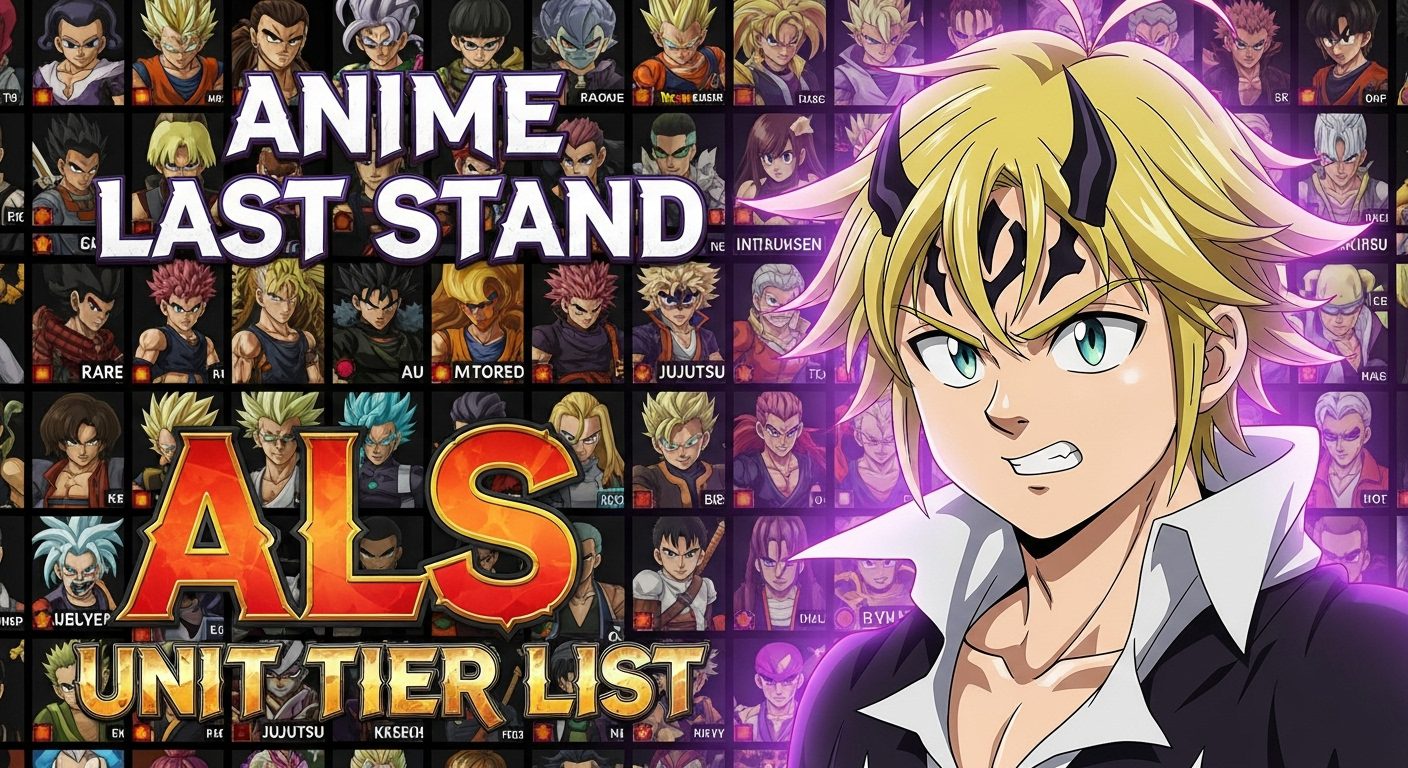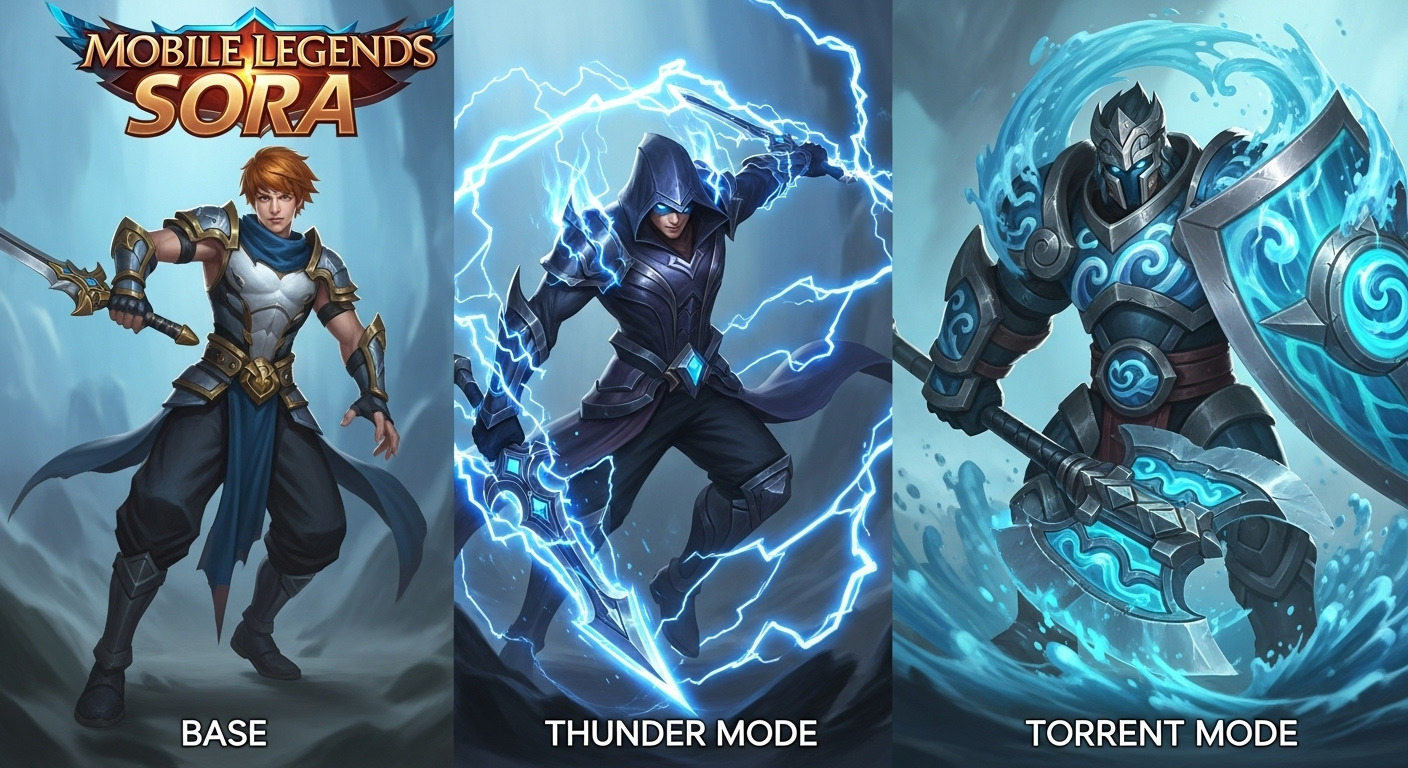

I’ve been playing Mobile Legends for years, and I can honestly say that Sora is one of the most exciting hero releases I’ve seen in a long time. When I first heard about a Fighter/Assassin hybrid with three different skill sets, I thought it was too good to be true. But after spending countless hours testing him on the Advanced Server, I’m here to tell you that Sora is absolutely revolutionary.
What makes me so excited about Sora isn’t just his unique transformation abilities – it’s how he completely changes the way you think about hero roles in Mobile Legends. I’ve never played a hero that can seamlessly switch from being a burst assassin to a tanky crowd controller mid-fight. It’s like having three different heroes in one, and trust me, once you master his mechanics, you’ll never want to go back to traditional single-role heroes.
Sora, officially known as “The Shifting Cloud,” is Mobile Legends’ latest addition to the roster and arguably the most versatile hero they’ve ever created. I’ve been following his development since the first leaks appeared, and what struck me immediately was how Moonton decided to break the traditional mold of single-role heroes.
When I first saw his design, I immediately thought of One Piece – and I wasn’t alone. The community has been buzzing with theories about a potential Luffy collaboration, especially given Sora’s stretchy, rubber-like animations and his ability to transform. While Moonton hasn’t officially confirmed any collaboration, the similarities are definitely there, and it’s got me even more excited about what’s coming.
What I love most about Sora is that he’s not just a hybrid hero – he’s a shape-shifter. In my experience, most “hybrid” heroes in Mobile Legends still lean heavily toward one role. But Sora? He genuinely transforms into completely different playstyles depending on which form you choose.
I’ve found that playing Sora requires a completely different mindset. You’re not just thinking about your current situation – you’re constantly planning your next transformation. Should I go Thunder mode for that squishy marksman? Or would Torrent mode be better to disrupt their team fight? It’s this strategic depth that makes him so addictive to play.
Before diving into his skills, I need to explain Sora’s passive because it’s the foundation of everything he does. This isn’t your typical passive ability – it’s the key to unlocking his true potential.
Every time Sora deals damage to enemy heroes or summoned units, he gains a Cloudstep stack. These stacks last for 6 seconds, and here’s the crucial part: once you reach 5 stacks, your ultimate becomes available. But here’s what makes it interesting – the ultimate has no traditional cooldown. Instead, it’s entirely dependent on building these stacks.
I’ll be honest, when I first started playing Sora, I was frustrated by this system. I kept trying to use my ultimate like a traditional ability, waiting for cooldowns that didn’t exist. But once I adapted my playstyle to focus on stack generation, everything clicked.
Through my testing, I’ve discovered that the most efficient way to build stacks is through aggressive trading in the early game. Sora’s base skills are designed specifically for this – they’re not meant to be your primary damage dealers, but rather stack generators that set up your transformations.
I always prioritize hitting enemy heroes over minions when building stacks. While you can generate stacks from jungle monsters and minions, hitting heroes gives you the same stack value and pressures your opponent at the same time. It’s all about efficiency.
Sora’s base form is what I like to call his “setup mode.” These aren’t flashy abilities that’ll secure kills on their own, but they’re incredibly effective at building stacks and positioning for transformations.

This is your primary stack generator and mobility tool rolled into one. Sora performs a double strike that generates 3 stacks immediately. If you hold and drag the joystick while casting, he’ll perform a short dash that repositions him.
I use this skill primarily for two purposes: quick stack generation and gap closing. The dash component is particularly useful for chasing down enemies or escaping ganks. What I love about this skill is its versatility – you can use it purely for stacks by casting it in place, or combine it with movement for aggressive plays.
Pro tip: I’ve found that using the dash component to position behind enemies before casting your second skill creates much better engagement opportunities.
This is where Sora’s design really starts to shine. The skill behaves differently based on your distance from the target. At close range, it hits twice and generates 2 stacks. At long range, it hits once but still generates 1 stack.
I primarily use this as a finishing move in base form or as additional stack generation when I’m close to my 5-stack threshold. The damage scaling is respectable, but remember – in base form, you’re playing for stacks, not kills.
My general approach in base form is aggressive but calculated. I look for opportunities to trade efficiently while building toward my transformation. The key is not committing too heavily – you want to build stacks and then transform for the real engagement.
I typically start fights by poking with Skill 2 from range, then using Skill 1 to dash in and generate more stacks. Once I hit 4 stacks, I become much more aggressive because I know my next ability hit will unlock my ultimate.
When you swipe left on your ultimate at 5 stacks, Sora transforms into Thunder mode, and this is where he becomes a true assassin. I’ve gotten more satisfying kills in this form than with any other assassin in the game.
The transformation itself provides several benefits:
What I love about Thunder mode is how responsive it feels. Everything is faster, snappier, and more aggressive. It’s like switching from driving a truck to a sports car.
This becomes a powerful kick attack with enhanced mobility. You can use the joystick to control direction, making it excellent for repositioning during fights or chasing fleeing enemies.
I use this skill primarily as a gap closer and burst component. The damage is substantial, and the mobility aspect means I can use it to escape after assassinations or chase down multiple targets in team fights.
This is where Thunder mode really shows its assassin identity. The leap attack can now pierce through multiple enemies, unlike the base form version. Additionally, hitting enemies reduces the cooldown, allowing for rapid successive casts.
I’ve found this skill to be incredibly powerful in team fights. You can leap through multiple enemies, applying the 50% slow effect to their entire team while dealing significant damage. The cooldown reduction means that in extended fights, you can use this skill multiple times.
The Thunder ultimate is pure burst potential. Sora performs approximately 14 rapid strikes in quick succession. I’ve seen this ability completely delete squishy targets before they can even react.
The key to maximizing this ultimate is positioning. I always try to cast it when I’m confident I can land most of the strikes on my primary target. Missing strikes significantly reduces your damage output.
My approach in Thunder mode is hit-and-run assassinations. I look for isolated targets or squishy carries in team fights. The mobility from Skill 1 and 2 allows me to get in, burst someone down with the ultimate, and escape before the enemy can respond.
I’ve learned that patience is crucial in Thunder mode. You have incredible burst potential, but you’re also quite fragile. I wait for the right moment – when key enemy abilities are on cooldown or when I can catch someone out of position.
Swiping right on your ultimate transforms Sora into Torrent mode, and this is where he becomes a disruptive tank-like presence. This form has completely changed how I think about team fighting.
The transformation provides:
I use Torrent mode when my team needs frontline presence or when I need to disrupt enemy formations. It’s not just about survivability – it’s about control.
This becomes a heavy punch attack that can stun enemies for 0.5 seconds. While the stun duration might seem short, I’ve found it’s incredibly disruptive in team fights.
I primarily use this skill to interrupt enemy channeled abilities or to set up combos for my teammates. The stun gives just enough time to position for your Skill 2 or for your team to follow up with additional crowd control.
This ability knocks enemies into the air and is significantly stronger at close range. The crowd control potential is enormous, especially in team fights.
What I love about this skill is its versatility. You can use it defensively to peel for your carries, or aggressively to set up team combinations. The knock-up effect goes through most immunity abilities, making it reliable crowd control.
The Torrent ultimate performs approximately 10 heavy strikes that deal area damage and slightly pull enemies toward the center. This is fantastic for team fight control.
I use this ultimate to zone enemies and control space. The pulling effect disrupts enemy positioning, while the area damage threatens their entire team. It’s not as bursty as Thunder mode, but it’s incredibly disruptive.
In Torrent mode, I play as a disruptive tank. I look for opportunities to engage enemy teams and create chaos. The crowd control from Skills 1 and 2, combined with the area control from the ultimate, makes you a nightmare to deal with in team fights.
I’ve found that Torrent mode excels at protecting your carries and disrupting enemy dive attempts. When their assassin tries to jump on your marksman, you can transform to Torrent and immediately crowd control them while providing a tanky presence.
After playing Sora extensively, I’ve developed several advanced strategies that can help you maximize his potential.
The key to mastering Sora is knowing when to use each transformation. Here’s my general decision-making process:
Choose Thunder when:
Choose Torrent when:
Managing your stacks efficiently is crucial for consistent transformations. I always try to maintain 3-4 stacks during the laning phase so I can quickly reach 5 when I need to transform.
One trick I’ve learned is to hit jungle monsters or minions to maintain stack timers when enemies aren’t available. The 6-second duration means you need to be proactive about maintaining your stacks.
Advanced Sora play involves cycling between forms efficiently. After using one transformation, you need to immediately start building stacks for your next one. I typically spend 15-20 seconds in each transformation before returning to base form to build new stacks.
Sora works incredibly well with certain team compositions:
With Thunder Mode:
With Torrent Mode:
Building Sora requires understanding both his dual nature and your intended transformation preferences.
Hunter Strike: Essential for both forms. Provides physical attack for Thunder mode and the unique passive helps with ability chaining.
Queen’s Wings: Incredible survivability item that benefits both transformations. The damage reduction helps Thunder mode survive burst, while the stats complement Torrent mode’s tankiness.
Blade of Despair: Pure damage item that’s particularly effective in Thunder mode. The execute passive helps secure kills during your burst rotations.
War Axe: Great if you’re planning to use Torrent mode frequently. The stacking attack and HP work perfectly with the transformation mechanics.
Oracle: Excellent defensive item for Torrent mode. The magic resistance and shield enhancement provide significant survivability.
Immortality: Sometimes necessary for Thunder mode play. Allows for more aggressive assassinations with a safety net.
My general build order focuses on core survivability first, then damage:
Understanding Sora’s weaknesses is crucial for both playing as and against him.
Stack Dependency: Without stacks, Sora is relatively weak. Smart enemies will try to avoid trading during your stack-building phase.
Transformation Cooldown: After using a transformation, there’s a period where you’re stuck in base form while building new stacks.
Form Predictability: Experienced opponents can predict which form you’ll choose based on the situation.
Karina: Her ultimate can quickly eliminate Thunder mode Sora before he can burst her down.
Johnson: His crowd control and mobility make it difficult for Sora to position properly for transformations.
Lancelot: Superior mobility and invulnerability frames can outplay both of Sora’s transformations.
Based on my experience, here are the most important tips for becoming proficient with Sora:
I genuinely believe Sora represents the future direction of Mobile Legends hero design. The complexity and versatility he offers raise the skill ceiling significantly while providing incredible depth for mastery.
The One Piece references in his design have me excited about potential anime collaborations. If Moonton does partner with One Piece, Sora could be just the beginning of a series of transformation-based heroes inspired by Devil Fruit abilities.
Sora’s versatility means he can fit into almost any team composition, which could significantly impact the draft phase in ranked and competitive play. I expect to see him become a highly contested pick once players master his mechanics.
Given his power level and versatility, I wouldn’t be surprised to see some balance adjustments in future patches. His transformation system is so unique that it may take time for Moonton to find the perfect balance point.
After extensive testing and gameplay, I can confidently say that Sora is not just worth learning – he’s essential for any serious Mobile Legends player. His versatility and mechanical depth provide a level of gameplay satisfaction that’s hard to find in other heroes.
The learning curve is steep, there’s no denying that. You’ll struggle with stack management, transformation timing, and form selection when you first start playing him. But once everything clicks, you’ll understand why I’m so excited about this hero.
Sora isn’t just a new hero – he’s a new way of thinking about Mobile Legends. He challenges the traditional role boundaries and rewards players who can adapt and think strategically. If you’re looking for a hero that will keep you engaged and constantly learning, Sora is your answer.
I’m planning to create more detailed guides covering specific matchups, advanced combos, and team fight strategies as I continue to master this incredible hero. Sora has completely reinvigorated my passion for Mobile Legends, and I think he’ll do the same for you.
Remember to bookmark this guide for future updates, and let me know in the comments which aspect of Sora’s gameplay you’d like me to cover in more detail next!
Sora’s transformation system sets him apart completely. While other heroes might have hybrid capabilities, Sora literally becomes a different hero with each transformation. I can go from playing like Hayabusa in Thunder mode to playing like Tigreal in Torrent mode, all within the same match.
Based on my experience, expect to spend at least 50-100 games becoming comfortable with his basics. True mastery – knowing exactly when to use each transformation and executing them flawlessly – takes significantly longer. I’m still discovering new techniques after extensive play.
Absolutely, but with a caveat. He’s incredibly powerful in the right hands, but his complexity means he’s not a hero you can pick up and immediately succeed with in ranked. I’d recommend mastering him in classic games first before taking him into ranked matches.
Start in practice mode to get comfortable with the transformation inputs and ability timings. Then move to classic games where you can experiment with different builds and strategies without ranking pressure. Focus on one transformation at a time until you’re comfortable with both.
Yes, Sora can jungle, but it’s not his optimal role. His stack system works better with frequent hero interactions, which means he’s more effective in lanes where he can build stacks off enemy heroes rather than jungle monsters alone.
This guide will be updated regularly as new strategies and balance changes emerge. Follow our Mobile Legends coverage for the latest Sora updates and advanced guides!

